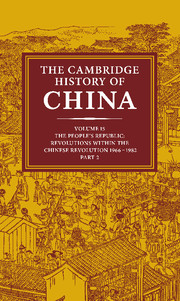Book contents
- Frontmatter
- 1 Mao Tse-tung's thought from 1949 to 1976
- PART I THE CULTURAL REVOLUTION: CHINA IN TURMOIL, 1966–1969
- PART II THE CULTURAL REVOLUTION: THE STRUGGLE FOR THE SUCCESSION, 1969–1982
- PART III THE CULTURAL REVOLUTION AND ITS AFTERMATH
- 6 China's economic policy and performance
- 7 Education
- 8 Creativity and politics
- PART IV LIFE AND LETTERS UNDER COMMUNISM
- PART V THE SEPARATED PROVINCE
- Epilogue: the onus of unity
- Appendixes: meetings and leaders
- Bibliographical essays
- Bibliography
- Index
- Map 1: China’s physical features
- Map 2. PRC: political (Wade–Giles romanization)
- Map 3. PRC: political (pinyin romanization)
- Map 7: Population
- References
7 - Education
from PART III - THE CULTURAL REVOLUTION AND ITS AFTERMATH
Published online by Cambridge University Press: 28 March 2008
- Frontmatter
- 1 Mao Tse-tung's thought from 1949 to 1976
- PART I THE CULTURAL REVOLUTION: CHINA IN TURMOIL, 1966–1969
- PART II THE CULTURAL REVOLUTION: THE STRUGGLE FOR THE SUCCESSION, 1969–1982
- PART III THE CULTURAL REVOLUTION AND ITS AFTERMATH
- 6 China's economic policy and performance
- 7 Education
- 8 Creativity and politics
- PART IV LIFE AND LETTERS UNDER COMMUNISM
- PART V THE SEPARATED PROVINCE
- Epilogue: the onus of unity
- Appendixes: meetings and leaders
- Bibliographical essays
- Bibliography
- Index
- Map 1: China’s physical features
- Map 2. PRC: political (Wade–Giles romanization)
- Map 3. PRC: political (pinyin romanization)
- Map 7: Population
- References
Summary
THE ROLE OF THE SCHOOLS IN THE GPCR
Education emerged as both a means and an end during the Cultural Revolution decade. School-system reform was one of the movement's ultimate aims. But it was also launched from the schools with students and teachers mobilized as vanguards. Their influence extended well beyond education, setting the stage for changes in education and all other sectors as well. Because in retrospect the dual nature of education's role was often confused, this chapter distinguishes between the mobilization phase, which launched the movement, and the consolidation phase, aimed at institutionalizing the “revolution in education” thereafter.
The events of 1966–68 can be interpreted as the mobilization phase of a mass movement like several others (beginning with the land revolution in the 1940s) that bear the Maoist imprint. This interpretation assumes that Mao, as initiator, had a larger aim in mind, namely, to ensure that the Chinese revolution would develop according to his own line for socialist construction and not that of others in the Party who disagreed with him. In this interpretation, the power struggle and mass participation in the assault against the bureaucracy are seen as the means rather than the end of the Cultural Revolution.
Mao's line had been introduced most systematically during the Great Leap Forward in 1958. Despite the economic disasters that had followed that venture, Mao was unwilling to abandon its goals even as the difficulties of achieving them divided the Party's leadership and crystallized the opposition against him. In accordance with his convictions, the socialist transformation of the economy was not sufficient; the realm of the superstructure had to be revolutionized as well.
Keywords
- Type
- Chapter
- Information
- The Cambridge History of China , pp. 540 - 593Publisher: Cambridge University PressPrint publication year: 1991
References
- 2
- Cited by

